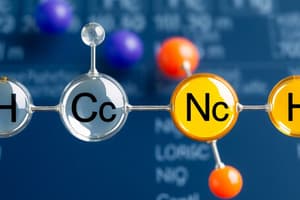Podcast
Questions and Answers
Which of the following is a method used to study the molecular structure of organic compounds?
Which of the following is a method used to study the molecular structure of organic compounds?
- X-ray crystallography
- Mass spectrometry
- Atomic force microscopy
- Infrared spectroscopy (correct)
What is the main difference between covalent and ionic compounds?
What is the main difference between covalent and ionic compounds?
- Covalent compounds are formed by the sharing of electrons, while ionic compounds are formed by the transfer of electrons.
- Covalent compounds contain molecules, while ionic compounds contain ions. (correct)
- Covalent compounds are generally more stable than ionic compounds.
- Covalent compounds have higher melting and boiling points than ionic compounds.
Which of the following is an example of an ionic compound?
Which of the following is an example of an ionic compound?
- Sodium chloride (NaCl) (correct)
- Carbon dioxide (CO2)
- Glucose (C6H12O6)
- Methane (CH4)
Which of the following is a type of ionic compound?
Which of the following is a type of ionic compound?
Why is understanding chemical compounds important in chemistry?
Why is understanding chemical compounds important in chemistry?
Which of the following is NOT a common type of ionic compound?
Which of the following is NOT a common type of ionic compound?
What do chemical compounds consist of?
What do chemical compounds consist of?
How are covalent compounds formed?
How are covalent compounds formed?
What do functional groups determine in a compound?
What do functional groups determine in a compound?
What is a common functional group that contains the -OH group?
What is a common functional group that contains the -OH group?
How are atoms arranged in chemical compounds?
How are atoms arranged in chemical compounds?
What do subscripts represent in the formula of covalent compounds?
What do subscripts represent in the formula of covalent compounds?
Flashcards are hidden until you start studying
Study Notes
Chemical Compounds
Overview
Chemical compounds refer to substances composed of identical molecules, comprised of two or more different elements. These elements can vary significantly in terms of atomic number, atomic mass, and position within the periodic table. Each element is identified by a unique symbol composed of one, two, or three letters derived from its current or original Latin name. The atoms within chemical compounds are arranged in specific ways based on their electronic configurations, leading to diverse properties and behaviors.
Covalent Compounds
Covalent compounds consist of molecules, where atoms share electrons to form stable bonds. Examples include methane (CH4) and water (H2O), which contain distinct CH4 and H2O molecules respectively. These molecules have predictable ratios of atoms, such as four hydrogen atoms per carbon atom in methane. Their formula indicates the types of atoms present, while subscripts represent the relative numbers of atoms.
Functional Groups
Functional groups are localized regions within molecules that cause characteristic reactions. They are responsible for determining much of a compound's physical and chemical properties. Common functional groups include alcohols (containing the -OH group), ethers (containing the -OR group), aldehydes (containing the -CHO group), and carboxylic acids (containing the -COOH group).
Spectroscopy of Organic Compounds
The study of organic compounds often involves spectroscopic techniques like infrared (IR) spectroscopy and nuclear magnetic resonance (NMR) spectroscopy. These methods help chemists understand the molecular structures and interactions of these compounds.
Ionic Compounds
In contrast to covalent compounds, ionic compounds contain ions rather than molecules. They form when elements lose or gain electrons, resulting in charged species. For example, sodium chloride (NaCl) contains equal numbers of positively charged sodium ions (Na+) and negatively charged chloride ions (Cl-). However, it does not exist as NaCl molecules—instead, the ions arrange themselves into a crystalline lattice structure.
Types of Ionic Compounds
There are several classes of ionic compounds. Some common ones include halides (e.g., sodium chloride, potassium iodide), oxides (e.g., iron(III) oxide, copper(II) oxide), sulfates (e.g., calcium sulfate, magnesium sulfate), nitrates (e.g., ammonium nitrate, silver nitrate), and carbonates (e.g., sodium carbonate, calcium carbonate).
Importance in Chemistry
Understanding chemical compounds and their classification is crucial in various fields of chemistry, including organic chemistry, inorganic chemistry, physical chemistry, and analytical chemistry. Knowledge about different types of compounds allows chemists to design and synthesize new materials, develop new technologies, and solve complex problems related to environmental sustainability, energy storage, and pharmaceuticals.
Studying That Suits You
Use AI to generate personalized quizzes and flashcards to suit your learning preferences.




